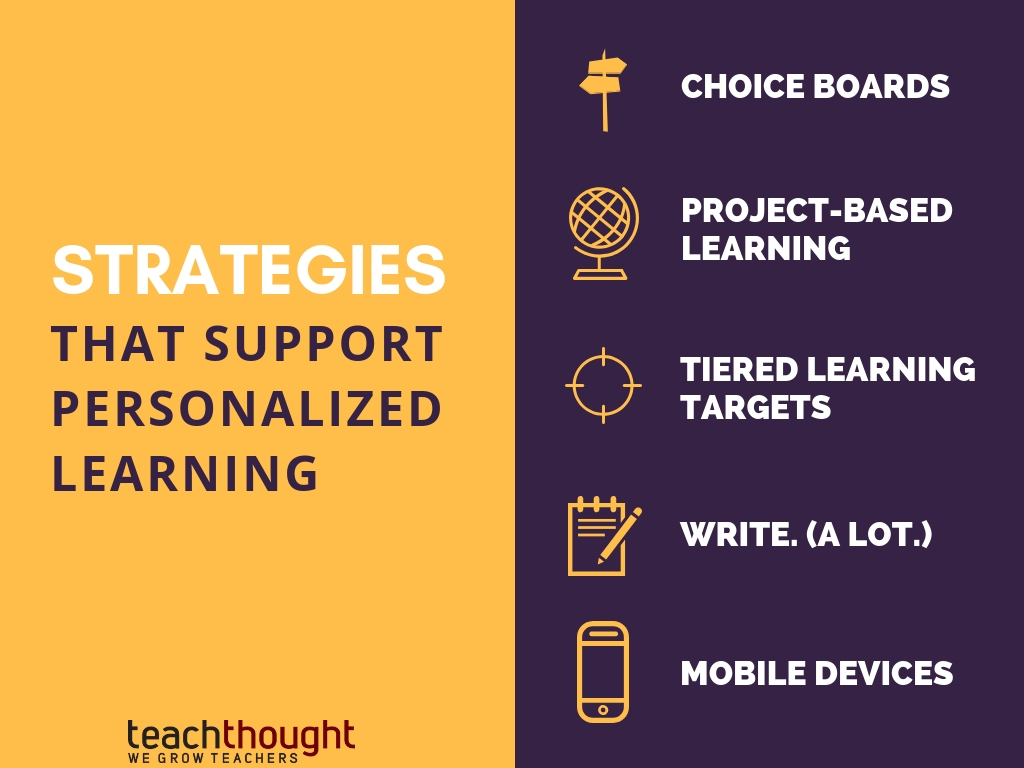
11 Easy Personalized Learning Strategies That Work
by TeachThought Staff
Personalized learning is something that many teachers strive for, but it can be easier to want it than make it happen.
Personalization is best created at the learning model and curriculum level rather shoe-horned in after the curriculum is done, but when you’re given lemons–well, you do the best you can.
1. Choice Boards
A choice board is a brilliantly simple tool that can provide scaffolding, tiering, use of Bloom’s taxonomy, support multiple learning styles, and more. You essentially take the idea behind an assignment–or better yet, a learning standard itself–and create four choices that, if completed, will address a given learning standard.
In fact, these can be done on the fly. Write a topic or standard on the board in the center of four squares, and in each square create an activity students can ‘do’ or things to demonstrate understanding of that topic or standard. Or better yet, let them come up with ways of their own.
2. Project-Based Learning
By its very nature, Project-Based Learning requires a significant role for the student. They take on authentic roles by documenting, capturing, reflecting, imagining, managing, and communicating. They actively choose topics and media, audiences and challenges, research sources and project timelines.
3. Tiered Learning Targets
Tiered learning targets aren’t exactly the high point of progressive learning but they can be useful in a tightly-monitored, high-pressure public school classroom. In extracting learning targets from academic standards, teachers create single statement of performance (often in “I can…” form). The problem is that this statement will rarely be the ‘just for me’ strand all learners need (unless, by chance, every student happens to understand a topic at the same level, which is unlikely).
So instead of one statement–I can explain the relationship between diction and tone–it can be broken up into three standards:
I can define diction and tone. (low)
I can explain the relationship between diction and tone. (middle)
I can explain how diction and tone converge to imply an author’s position on a topic. (high)
This helps in terms of assessment–identifying where learners are stuck–and offers an oar to students drowning in the rigor. The ‘low’ target provides an accessible starting point where they can feel honored. “Hey, that’s about where I am” rather than “I have no idea what she’s talking about.”
4. Writing
Writing as assessment.
Writing to learn.
Quick prompts.
Write-Arounds.
Writing to demonstrate learning.
Formal writing. Informal writing.
Academic writing.
Blogging.
Starting at various stages of the writing process.
Revisiting old writing.
Writing to support meta-cognition.
Reflective writing.
Personal writing.
Writing about reading.
Writing about the writing itself.
Stream of Consciousness writing.
RAFT assignments.
Writing helps personalize learning, is highly flexible, and imposes a cognitive load on learners that is hard to match in terms of both skill and content knowledge.
5. Place-Based Education
A macro modeling strategy rather than a singular teaching strategy, place-based education uses a specific location–the student’s home or neighborhood, for example–to draw learning opportunities (problem-based learning, for example). These ‘places’ can also personalize learning by providing audiences or collaboration partners authentic to individual students, two tenets at the core of personalized learning.
See also the Different Types Of Project-Based Learning
6. Inquiry-Based Learning
Like Placed-Based Learning, Inquiry-Based Learning centers the student because it uses (or rather often uses) their questions they have developed to guide their learning process.
7. Learning Stations
This one is a bit down the list because it’s really more of a differentiation strategy than a personalized learning strategy. That said,
8. Goal-setting
As with learning stations, goal-setting alone won’t produce personalized learning but used in the company of a flexible curriculum or with an open-ended learning model, goal-setting can help guide individual students towards individualized goals via individualized means, tools, and scheduling.
Another example? Goal-setting + student-led conferences that revisit those goals while also providing adequate and authentic flexibility to meet that student’s needs as they meet/fail to meet those goals.
9. Personalized Learning Plans
Similar to goal-setting, a personalized learning plan is more detailed–a clear and documented plan right from the beginning of the year to create curriculum and use learning models and teaching and learning strategies to meet the individual needs of that student. Individualized Education Plans (IEPs) are a kind of ‘personalized learning plan,’ for example.
10. Competency-Based Learning/Mastery Learning
This is another that is generally more of a differentiation strategy (same content in different ways) rather than a personalized learning strategy (different content in different ways). That said, used to facilitate the latter rather than the former, each of these approaches promotes personalization of learning for students in sustainable ways that may not require Herculean effort on the part of the teacher. In each approach, students move at their own pace to demonstrate mastery of content, moving on as soon as they are able to do so, or drawing attention to their individualized needs when they are not.
11. Sustained use of 1:1/Mobile Devices
By placing a smartphone, iPad, or notebook computer on the lap of a student, they immediately have direct access to media tools and information. This doesn’t mean learning is suddenly personalized by using a mobile device, but the tool that absolutely makes it possible is there. Rather than listening, they are accessing, a great starting point for personalized learning.
11 Easy Personalized Learning Strategies That Work
